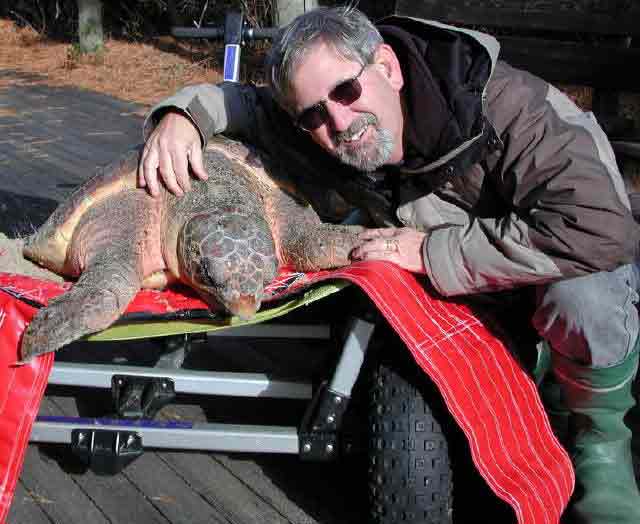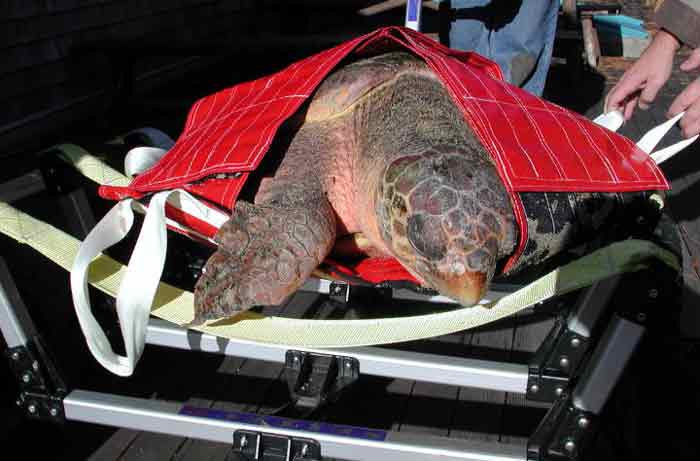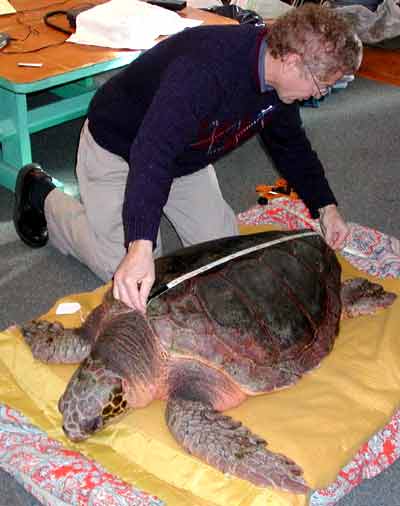Huge Loggerhead Strands on Truro Beach — 2 December 2002
Gusting 30+ knot westerlies, coupled with below-freezing temperatures, proved too much for a huge loggerhead sea turtle. Pounding surf tossed her upside down on the beach at Great Hollow in Truro. A beachcomber spotted her on the morning high tide and called the turtle hot line at Mass Audubon’s Wellfleet Bay Wildlife Sanctuary. He pulled her above the water line and covered her with seaweed to prevent hypothermia from exposure to frigidly cold winds. Her internal body temperature had already plunged to 40.2 degrees Fahrenheit!

Dispatched to the spot with the caution, “Don, this may be the first loggerhead of the year,” I became suspicious when I saw the size of the seaweed pile on the beach. Kemp’s ridleys, even the largest ones, range from 5 to 15 pounds. Loggerheads, even the smallest ones, range from 25 to 65 pounds. The largest loggerhead found in Cape Cod, nicknamed Tiny, was rescued from Sea Street beach in Dennis in 1999 and weighed a little over 200 pounds. One look beneath the seaweed and I phoned back with the message, “Houston, we have a problem.” I could barely raise her off the sand and had only begun to consider options for lifting her up the 50 foot staircase from the base of the hollow to the parking lot on the dune above.
Luckily, Kara Dwyer, of the National Marine Fisheries Service, had ordered a sea turtle stretcher built especially for loggerheads. It arrived just in time and wrapped her perfectly snug in its grasp. With four bearers we managed to lug the turtle up a steep, but manageable private dune path where I illegally parked my jeep. At the Sanctuary we transferred her to a turtle cart designed by naturalist Dennis Murley.

Bob Prescott, sanctuary director and sea turtle coordinator, bathed her to remove sand and salt, and to clean her of beach debris before we moved her into recovery room dry dock. In addition to cold bay waters and even colder weather conditions, this loggerhead had been compromised by an old, healed injury that left a scar on the right side of her plastron and a large section of her right front flipper missing. The New England Aquarium requested her immediate transport to Boston, and a volunteer driver was tagged to make the two hour trip.
  The tale of the tape shows her with a carapace length about 5.5 inches shorter than the record holder Tiny. In all, from nose to tail, today’s loggerhead is about four feet long and two feet wide. We don’t have a scale to accommodate turtles of her size, so we’ll have to wait for the aquarium to report her precise weight. Those who carried her from beach to dune top and then from jeep to recovery room estimate weights in the range from 150 to 175 pounds, based on internal cramps and pangs while lifting. The tale of the tape shows her with a carapace length about 5.5 inches shorter than the record holder Tiny. In all, from nose to tail, today’s loggerhead is about four feet long and two feet wide. We don’t have a scale to accommodate turtles of her size, so we’ll have to wait for the aquarium to report her precise weight. Those who carried her from beach to dune top and then from jeep to recovery room estimate weights in the range from 150 to 175 pounds, based on internal cramps and pangs while lifting.
While this loggerhead certainly stole the lion share of attention, we shouldn’t forget the big picture. With winds still howling over 30 knots and an 8:00 p.m. high tide this evening, we leapfrogged beaches from Truro to Orleans until nearly midnight tonight. Totals for the 2002 season stand at 169 cold-stunned sea turtles: 159 Kemp’s ridleys, critically endangered and the rarest sea turtle in the world; one loggerhead; and nine green sea turtles.
There’s now little doubt that 2002 will be the second largest stranding year on record, surpassing 1995 sometime this week, and we’ve never recovered nine green sea turtles in any year. As of today rankings for the top five stranding years read:

|